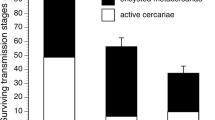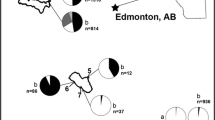Abstract
Digenetic trematodes have complex life cycles involving multiple hosts and free-living larval stages. Some species have 2 larval stages that infect snails, with miracidia and cercariae using these molluscs as first and second intermediate hosts, respectively. Although both larval stages may infect the same snail species, this is accomplished using different chemical cues and may be influenced by different biotic and abiotic factors. Significant differences in the infection patterns of these parasitic stages regarding host size and density were observed in 2 separate field studies. The prevalence of sporocysts/rediae and mean abundance of Echinostoma spp. metacercariae infection were positively correlated with host size, while the prevalence of Echinostoma spp. cercariae infection was positively correlated with host density across 5 different pulmonate snail species. Larger snails within a given species tend to be older and the increased exposure time may be responsible for the positive correlations with host size. Additionally, infection by miracidia in more vagile snail hosts was influenced by trematode species richness at a sample site, which may be attributed to increased encounter rate as a result of increased movement by the snail hosts. Echinostoma spp. metacercariae prevalence was influenced by host density, possibly due to high abundances of larval clones and their response to more generalized chemical cues attributed to low host specificity by cercariae. Although they can infect the same gastropod hosts, miracidia and cercariae infection are dependent on different factors at both the individual and population level of their snail hosts.
Similar content being viewed by others
References
Anderson R.M., Mercer J.G., Wilson R.A., Carter N.P. 1982. Transmission of Schistosoma mansoni from man to snail: Experimental studies of miracidial survival and infectivity in relation to larval age, water temperature, host size and host age. Parasitology, 85, 339–360. DOI: 10.1017/S0031182000055323
Boss C.N., Laman T.G., Blankespoor H.D. 1984. Dispersal movements of four species of pulmonate and operculate snails in Douglas Lake, Michigan. The Nautilus, 98, 80–83
Bush A.O., Lafferty K.D., Lotz J.M., Shostak A.W. 1997. Parasitology meets ecology on its own terms: Margolis et al. revisited. Journalof Parasitology, 83, 575–583. DOI: 10.2307/3284227
Byers J.E., Blakeslee A.M.H., Linder E., Cooper A.B., Maguire T.J. 2008. Controls of spatial variation in the prevalence of trematode parasites infecting a marine snail. Ecology, 89, 439–451. DOI: 10.1890/06-1036.1
Campbell R.A. 1997. Host-finding behavior of Cotylurus flabelliformis (Trematoda: Strigeidae) cercariae for snail hosts. Folia Parasitologica, 44, 199–204
Carter N.P., Anderson R.M., Wilson R.A. 1982. Transmission of Schistosoma mansoni from man to snail: Laboratory studies on the influence of snail and miracidial densities on transmission success. Parasitology, 85, 361–372. DOI: 10.1017/S0031182000055335
Charnov E., Orians G., Hyatt K. 1976. Ecological implications of resource depression. American Naturalist, 110, 247–259
Criscione C.D., Blouin M.S. 2007. Minimal selfing, few clones, and no among-host genetic structure in a hermaphroditic parasite with asexual larval propagation. Evolution, 60, 553–562. DOI: 10.1111/j.0014-3820.2006.tb01136.x
Detwiler J.T., Minchella D.J. 2009. Intermediate host availability masks the strength of experimentally-derived colonisation patterns in echinostome trematodes. International Journal for Parasitology, 39, 585–590. DOI: 10.1016/j.ijpara.2008.10.008
Detwiler J.T. 2010. The molecular ecology of echinostome trematodes: Elucidating the phylogenetics and transmission dynamics of a freshwater helminth parasite. Ph.D. Thesis, Purdue University, West Lafayette, Indiana, USA Dillon R.T. 2000. Gastropod autoecology. In: Dillon R. T. (Ed.). The ecology of freshwater molluscs, Cambridge University Press, Cambridge, UK, pp. 57–116
Esch G.W., Fernandez J.C. 1994. Snail-trematode interactions and parasite community dynamics in aquatic systems: A review. The American Midland Naturalist, 131, 209–237. DOI: 10.2307/2426248
Esch G.W., Barger M.A., Fellis K.J. 2002. The transmission of digenetic trematodes: Style, elegance, complexity. Integrative Comparative Biology, 42, 304–312. DOI: 10.1093/icb/42.2.304
Esteban J.C., Munoz-Antoli C. 2009. Echinostomes: Systematics and life cycles. In: Fried B.R., and Toledo R. (Eds.) The biology of echinostomes: From the molecule to the community, Springer, LLC, New York, New York, pp. 1–34
Evans N.A., Whitfield P.J., Dobson A.P. 1981. Parasite utilization of a host community: The distribution and occurrence ofmetacercarial cysts of Echinoparyphium recurvatum (Digenea: Echinostomatidae) in seven species of molluscs at Harting Pond, Sussex. Parasitology, 83, 1–12. DOI: 10.1017/S0031182000049982
Faltynkova A., Nasincova V., Kablaskova L. 2007a. Larval trematodes (Digenea) of planorbid snails (Gastropoda: Pulmonata) in central Europe: A survey of species and key to their identification. Systematic Parasitology, 69, 155–178. DOI: 10.1007/s11230-007-9127-1
Faltynkova A., Nasincova V., Kablaskova L. 2007b. Larval trematodes (Digenea) of the great pond snail Lymnaea stagnalis (L.), (Gastropoda, Pulmonata) in central Europe: A survey of species and key to their identification. Parasite, 14, 39–51. DOI: 10.1051/parasite/2007141039
Fenton A., Fairbairn J.P., Norman R., Hudson PJ. Parasite transmission: Reconciling theory and reality. Journal of Animal Ecology, 71, 893–905. DOI: 10.1046/j.1365-2656.2002.00656.x
Fernandez J., Esch G.W. 1991a. Guild structure of larval trematods in the snail Helisoma anceps: Patterns and processes at the individual host level. Journal of Parasitology, 77, 528–539. DOI: 10.2307/3283156
Fernandez J., Esch G.W. 1991b. The component community structure of larval trematodes in the pulmonate snail Helisoma anceps. Journal of Parasitology, 77, 540–550. DOI: 10.2307/3283157
Haas W. 2003. Parasitic worms: Strategies of host finding, recognition and invasion. Zoology, 106, 349–364. DOI: 10.1078/0944-2006-00125
Haas W., Korner M., Hutterer E., Wegner M., Haberl B.. 1995. Finding and recognition of the snail intermediate hosts by 3 species of echinostome cercariae. Parasitology, 110, 133–142. DOI: 10.1017/S0031182000063897
Haberl B., Korner M., Spengler Y., Hertel J., Kalbe M., Haas W. 2000. Host-finding in Echinostoma caproni: Miracidia and cercariae use different signals to identify the same snail species. Parasitology, 120, 479–486
Hechinger R.F., Wood A.C., Kuris A.M. 2011. Social organization in a flatworm: Trematode parasites form soldier and reproductive castes. Proceedings of the Royal Society of London, 278, 656–665. DOI: 10.1098/rspb.2010.1753
Johnson P.T.J., Preston D.L., Hoverman J.T., Henderson J.S., Paull S.H., Richgels K.L.D., Redmond M.D. 2012. Species diversity reduces parasite infection through cross-generation effects on host abundance. Ecology, 93, 56–64. DOI: 10.1890/11-0636.1
Jokela J., Lively C.M. 1995. Spatial variation in infection by digenetic trematodes in a population of freshwater snails (Potamopyrgus antipodarum). Oecologia, 103, 509–517. DOI: 10.1007/BF00328690
Kalbe M., Haberl B., Haas W. 2000. Snail host finding by Fasciola hepatica and Trichobilharzia ocellata: Compound analysis of “miracidia-attracting glycoproteins.” Experimental Parasitology, 96, 231–242. DOI: 10.1006/expr.2000.4579
Kuris A.M., Warren J. 1980. Echinostome cercarial penetration and metacercarial encystment as mortality factors for a second intermediate host, Biomphalaria glabrata. Journal of Parasitology, 66, 630–635. DOI: 10.2307/3280520
Kuris A.M., Lafferty K.D. 1994. Community structure: Larval trematodes in snail hosts. Annual Review of Ecology and Systematics, 25, 189–217
Loy C., Haas W. 2001. Prevalence of cercariae from Lymnaea stagnalis snails in a pond system in Southern Germany. Parasitology Research, 87, 878–882. DOI: 10.1007/s004360100462
McCarthy A.M. 1990. The influence of second intermediate host dispersion pattern upon the transmission of cercariae of Echinoparyphium recurvatum (Digenea: Echinostomatidae). Parasitology, 101, 43–47. DOI: 10.1017/S0031182000079737
McCarthy A.M. 1999a. Photoperiodic cercarial emergence patterns of the digeneans Echinoparyphium recurvatum and Plagiorchis sp. from a mixed infection in Lymnaea peregra. Journal of Helminthology, 73, 59–62. DOI: 10.1017/S0022149X99 000074
McCarthy A.M. 1999. The influence of temperature on the survival and infectivity of the cercariae of Echinoparyphium recurvatum (Digenea: Echinosomatidae). Parasitology, 118, 383–388
Morley N.J. 2012. Thermodynamics of miracidial survival and metabolism. Parasitology, 139, 1640–1651. DOI: 10.1017/S00 31182012000960
Morley N.J., Crane M., Lewis J.W. 2004a. Influence of cadmium exposure on the incidence of first intermediate host encystment by Echinoparyphium recurvatum cercariae in Lymnaea peregra. Journal of Helminthology, 78, 329–332. DOI: 10.1079/JOH2004267
Morley N.J., Lewis J.W., Adam M.E. 2004b. Metacercarial utilization of a naturally infected single species (Lymnaea peregra) snail community by Echinoparyphium recurvatum. Journal of Helminthology, 78, 51–56. DOI: 10.1079/JOH2003201
Morley N.J., Lewis J.W. 2015. Thermodynamics of trematode infectivity. Parasitology, 142, 585–597. DOI: 10.1017/S00311 8201400163
Muñoz-Antoli C., Toledo R., Esteban J. 2000. The life cycle and transmission dynamics of the larval stages of Hypoderaeum conoideum. Journal of Helminthology, 74, 165–172. DOI: 10.1017/S0022149X00000238
Muñoz-Antoli C., Trelis C.M., Espert A., Toledo R., Esteban J.G. 2003. Interactions related to non-host snails in the host-finding process of Euparyphium albuferensis and Echinostoma friedi (Trematoda: Echinostomatidae) miracidia. Parasitology Research, 91, 353–356. DOI: 10.1007/s00436-003-0968-5
Negron-Aponte H., Jobin W.R. 1977. Guidelines for spacing and timing of samples to detect populations of Schistosoma mansoni cercariae in the field. International Journal for Parasitology, 7, 123–126. DOI: 0.1016/0020-7519(77)90078-9
Rauch G., Kalbe M., Reusch T.B.H. How a complex life cycle can improve a parasite’s sex life. Journal of Evolutionary Biology, 18, 1069–1075. DOI: 10.1111/j.1420-9101.2005.00895.x
Sandland G.J., Goater C.P., Danylchuk A.J. Population dynamics of Ornithodiplostomum ptychocheilus metacercariae in fathead minnows (Pimephales promelas) from four northern Alberta lakes. Journal of Parasitology, 87, 744–748. DOI: 10.1645/0022-3395
Sapp K.K., Esch G.W. 1994. The effects of spatial and temporal heterogeneity as structuring forces for parasite communities in Helisoma anceps and Physa gyrina. American Midland Naturalist, 132, 91–103. DOI: 10.2307/2426204
Schmidt K.A., B. Fried. 1996. Emergence of cercariae of Echinostoma trivolvis from Helisoma trivolvis under different conditions. Journal of Parasitology, 82, 674–676. DOI: 10.2307/3283806
Sorensen R.E., Minchella D.J. 1998. Parasite influences on host life history: Echinostoma revolutum parasitism of Lymnaea elodes snails. Oecologia, 115, 188–195. DOI: 10.1007/s004420050507
Toledo R., Muñoz-Antoli C., Perez M., Esteban J.G. 1999. Survival and infectivity of Hypoderaeum conoideum and Euparyphium albuferensis cercariae under laboratory conditions. Journal of Helmintology, 73, 177–182. DOI: 10.1017/S0022149X9900027X
Toledo R., Espert A., Carpena I., Muñoz-Antoli C., Esteban J.G. 2003. An experimental study of the reproductive success of Echinostoma friedi (Trematoda: Echinostomatidae) in the golden hamster. Parasitology, 126, 433–441. DOI: 10.1017/S0031182003213068
Toledo R., Carpena I., Espert A., Sotillo J., Muñoz-Antoli C., Esteban J.G. 2006. Transmission success of Echinostoma friedi (Trematoda: Echinostomatidae) in rats. Journal of Parasitology, 92, 16–20. DOI: 10.1645/GE-574R1.1
Upatham E.S. 1972. Exposure or caged Biomphalariaglabrata (Say) to investigate dispersion of miracidia of Schistosoma mansoni Sambon in outdoor habitats in St. Lucia. Journal of Helminothology, 46, 297–306
Upatham E.S. 1973. Location of Biomphalaria glabrata (Say) by miracidia of Schistosoma mansoni Sambon in natural standing and running waters on the West Indian Island of St. Lucia. International Journal for Parasitology, 3, 289–297. DOI: 10.1016/0020-7519(73)90106-9
Upatham E.S. 1974. Infectivity of Schistosoma mansoni cercariae in natural St. Lucian habitats. Annals of Tropical Medicine & Parasitology, 68, 235–236. DOI: 10.1080/00034983.1974.11686941
Williams J.A., Esch G.W. 1991. Infra- and component community dynamics in the pulmonate snail Helisoma anceps, with special emphasis on the hemiurid trematode Halipegus occidualis. Journal of Parasitology, 77, 246–253. DOI: 10.2307/3283091
Wilson R.A., Taylor S.L. 1978. The effect of variations in host and parasite density on the level of parasitization of Lymnaea truncatula by Fasciola hepatica. Parasitology, 76, 91–98. DOI: 10.1017/S0031182000047429
Zimmermann M.R., Luth K.E., Esch G.W. 2014a. Differences in snail ecology lead to infection pattern variation of Echinostoma spp. larval stages. Acta Parasitologica, 59, 502–509. DOI: 10.2478/s11686-014-0275-6
Zimmermann M.R., Luth K.E., Esch G.W. 2014b. Microhabitat differences surrounding a pond affects the distribution of trematode parasites among a pulmonate snail community. Helminthologia, 51, 301–308. DOI: 10.2478/s11687-014-0245-4
Author information
Authors and Affiliations
Corresponding author
Rights and permissions
About this article
Cite this article
Zimmermann, M.R., Luth, K.E. & Esch, G.W. Tranmission pattern differences of miracidia and cercariae larval stages of digenetic trematode parasites. Acta Parasit. 61, 680–688 (2016). https://doi.org/10.1515/ap-2016-0095
Received:
Revised:
Accepted:
Published:
Issue Date:
DOI: https://doi.org/10.1515/ap-2016-0095




